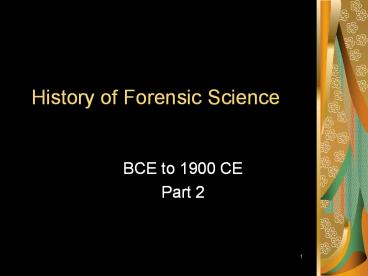History of Forensic Science - PowerPoint PPT Presentation
1 / 21
Title:
History of Forensic Science
Description:
* History of Forensic Science 1880 Henry ... * History of Forensic Science 1894 Alfred Dreyfus of France was convicted of treason based on a mistaken handwriting ... – PowerPoint PPT presentation
Number of Views:290
Avg rating:3.0/5.0
Title: History of Forensic Science
1
History of Forensic Science
- BCE to 1900 CE
- Part 2
2
History of Forensic Science
- 1856 Sir William Herschel, a British officer
working for the Indian Civil service, began to
use thumbprints on documents both as a substitute
for written signatures for illiterates and to
verify document signatures.
3
History of Forensic Science
- 1862 The Dutch scientist J. (Izaak) Van Deen
developed a presumptive test for blood using
guaiac, a West Indian shrub.
4
History of Forensic Science
- 1863 The German scientist Schönbein first
discovered the ability of hemoglobin to oxidize
hydrogen peroxide making it foam. This resulted
in first presumptive test for blood.
5
History of Forensic Science
- 1864 Odelbrecht first advocated the use of
photography for the identification of criminals
and the documentation of evidence and crime
scenes.
6
History of Forensic Science
- 1877 Thomas Taylor, microscopist to U.S.
Department of Agriculture suggested that markings
of the palms of the hands and the tips of the
fingers could be used for identification in
criminal cases. - Although reported in the American Journal of
Microscopy and Popular Science and Scientific
American, the idea was apparently never pursued
from this source.
7
History of Forensic Science
- 1879 Rudolph Virchow, a German pathologist, was
one of the first to both study hair and recognize
its limitations.
8
History of Forensic Science
- 1880 Henry Faulds, a Scottish physician working
in Tokyo, published a paper in the journal Nature
suggesting that fingerprints at the scene of a
crime could identify the offender. - In one of the first recorded uses of fingerprints
to solve a crime, Faulds used fingerprints to
eliminate an innocent suspect and indicate a
perpetrator in a Tokyo burglary.
9
History of Forensic Science
- 1882 Gilbert Thompson, a railroad builder with
the U.S Geological Survey in New Mexico, put his
own thumbprint on wage chits to safeguard himself
from forgeries.
10
History of Forensic Science
- 1883 Alphonse Bertillon, a French police
employee, identified the first recidivist based
on his invention of anthropometry.
11
History of Forensic Science
- 1887 Arthur Conan Doyle published the first
Sherlock Holmes story in Beetons Christmas
Annual of London.
12
History of Forensic Science
- 1889 Alexandre Lacassagne, professor of forensic
medicine at the University of Lyons, France, was
the first to try to individualize bullets to a
gun barrel. - His comparisons at the time were based simply on
the number of lands and grooves.
13
History of Forensic Science
- 1891 Hans Gross, examining magistrate and
professor of criminal law at the University of
Graz, Austria, published Criminal Investigation,
the first comprehensive description of uses of
physical evidence in solving crime. - Gross is also sometimes credited with coining the
word criminalistics.
14
History of Forensic Science
- 1892 Sir Francis Galton published Fingerprints,
the first comprehensive book on the nature of
fingerprints and their use in solving crime.
15
History of Forensic Science
- 1892 Juan Vucetich, an Argentinean police
researcher, developed the fingerprint
classification system that would come to be used
in Latin America. - After Vucetich implicated a mother in the murder
of her own children using her bloody
fingerprints, Argentina was the first country to
replace anthropometry with fingerprints.
16
History of Forensic Science
- 1894 Alfred Dreyfus of France was convicted of
treason based on a mistaken handwriting
identification by Bertillon.
17
History of Forensic Science
- 1896 Sir Edward Richard Henry developed the print
classification system that would come to be used
in Europe and North America. - He published Classification and Uses of Finger
Prints.
18
History of Forensic Science
- 1898 Paul Jesrich, a forensic chemist working in
Berlin, Germany, took photomicrographs of two
bullets to compare, and subsequently
individualize, the minutiae.
19
History of Forensic Science
- 1901 Paul Uhlenhuth, a German immunologist,
developed the precipitin test for species. He was
also one of the first to institute standards,
controls, and QA/QC procedures. - Wassermann (famous for developing a test for
syphilis) and Schütze independently discovered
and published the precipitin test, but never
received due credit.
20
History of Forensic Science
- 1900 Karl Landsteiner first discovered human
blood groups and was awarded the Nobel prize for
his work in 1930. - Max Richter adapted the technique to type stains.
21
History of Forensic Science
- This is one of the first instances of performing
validation experiments specifically to adapt a
method for forensic science. - Landsteiner's continued work on the detection of
blood, its species, and its type formed the basis
of practically all subsequent work.














![[DOWNLOAD]⚡️PDF✔️ The Unvarnished Truth: Exploring the Material History of Paintings (English an PowerPoint PPT Presentation](https://s3.amazonaws.com/images.powershow.com/10051209.th0.jpg?_=20240608117)

![[DOWNLOAD]⚡️PDF✔️ The Unvarnished Truth: Exploring the Material History of Paintings (English an PowerPoint PPT Presentation](https://s3.amazonaws.com/images.powershow.com/10050637.th0.jpg?_=20240608128)














